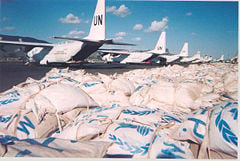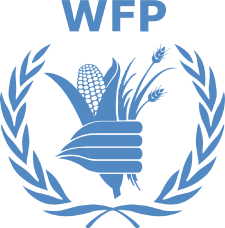World Food Programme
The World Food Programme (WFP), the world's largest humanitarian agency, provides food to more than ninety million people in eighty countries. WFP is the food aid branch of the United Nations. From its headquarters in Rome and more than 80 country offices around the world, WFP works to help people who are unable to produce or obtain enough food for themselves and their families.
In addition to emergency food aid, WFP focuses on relief and rehabilitation, development aid, and special operations, such as making food systems more resilient against climate change and political instability. It is an executive member of the United Nations Development Group, which collectively aims to fulfill the 17 Sustainable Development Goals (SDG), and has prioritized achieving SDG 2 for "zero hunger" by 2030.
The World Food Programme was awarded the Nobel Peace Prize in 2020 for its efforts to provide food assistance in areas of conflict.
Overview
The WFP was first conceived at the 1961 Food and Agricultural Organization (FAO) Conference, when George McGovern, director of the U.S. Food for Peace Program, proposed establishing a multilateral food aid program.[1] WFP was formally established in 1963, by the FAO and the United Nations General Assembly on a three-year experimental basis. In 1965, the program was extended and is now supported on a continuing basis.
Organization
The WFP is governed by the WFP Executive Board, which consists of 36 member states. The WFP Executive Director, who is appointed jointly by the UN Secretary-General and the Director-General of the Food and Agriculture Organization of the United Nations, heads the WFP secretariat, which is headquartered in Rome.[2]
David Beasley, previously Governor of the U.S. state of South Carolina, was appointed executive director in March 2017 for a five-year term. Previous executive directors include Ertharin Cousin (April 2012 – April 2017), Josette Sheeran (April 2007 – April 2012), James T. Morris (April 2002 – April 2007), Catherine Bertini (April 1992 – April 2002), and James Ingram (April 1982 – April 1992).
Goals and strategies
WFP strives to eradicate hunger and malnutrition, with the ultimate goal of eliminating the need for food aid - "Zero Hunger."[3]
According to its mission statement, the core strategies behind WFP activities are to provide food aid to:
- Save lives in refugee and other emergency situations
- Improve the nutrition and quality of life of the most vulnerable people at critical times in their lives
- Help build assets and promote the self-reliance of poor people and communities, particularly through food for work programs.
WFP food aid is also directed to fight micro-nutrient deficiencies, reduce child mortality, improve maternal health, and combat disease, including HIV/AIDS. Food for work programs of WFP provide food for people while they work to rebuild damaged infrastructure and replant crops following crisis. This program also helps to strengthen environmental and economic stability and agricultural production.
Activities

WFP has been active in humanitarian aid for over half a century. Experience has shown that fighting hunger is not a straightforward proposition, but requires collective action on various levels, aimed at various groups, drawing on various contexts and including various stakeholders. It involves not just delivering food, but also transferring cash, and transferring knowledge. This knowledge must be culturally embedded, knowledge that makes local sense, and is received on the basis of partnership.[4]
Programmes
By adopting smallholder-friendly procurement, WFP contributes to strengthening local economies and supporting the increased resilience and productivity of rural communities. The Purchase for Progress (P4P) program encourages national governments and the private sector to buy food in ways that benefit smallholders. P4P assists smallholding farmers by offering them opportunities to access agricultural markets and to become competitive players in the marketplace. P4P has expanded to some 35 countries, and helped transform the way more than one million smallholder farmers in Africa, Latin America, and Asia interact with markets. The project also trains farmers in improved agricultural production, post-harvest handling, quality assurance, group marketing, agricultural finance, and contracting with WFP. Women, whose role in farming is often unpaid and labor-intensive, are particularly encouraged to take part in decision-making and benefit economically from their work.[5]
Experience built up over almost five decades of working in emergency situations has demonstrated that giving food only to women helps to ensure that it is spread evenly among all household members. Based on this understanding, WFP responded to the 2010 Haiti earthquake by distributing food aid only to women. School-feeding and/or take-home ration programs in 71 countries help students focus on their studies and encourage parents to send their children, especially girls, to school.
Emergency Response procedures
WFP has a system of classifications known as the Emergency Response Procedures designed for situations that require an immediate response. This response is activated under the following criteria:
- When human suffering exists and domestic governments cannot respond adequately
- The United Nations reputation is under scrutiny
- When there is an obvious need for aid from WFP
The Emergency Response Classifications are divided as follows, with emergency intensity increasing with each level:[6]
- Level 1 – Response is activated. Resources are allocated to prepare for WFP's local office to respond
- Level 2 – A country's resources require regional assistance with an emergency across one or multiple countries/territories
- Level 3 (L3) – The emergency overpowers WFP's local offices and requires a global response from the entire WFP organization
Funding
WFP has no independent funds. All operations are funded by donations from world governments, corporations, and private donors. On average, over 60 governments contribute to the humanitarian and development projects of WFP, providing the main source of funds.[7] The private sector also provides many partners committed to the goal of Zero Hunger, contributing trough corporate-giving programs, as well as offering knowledge, expertise, and positioning to strengthen operations. Personal donations are also a significant source of funding for WFP programs.
Partners
WFP has numerous partners to coordinate and cooperate with in emergencies and development projects. These partners include UN agencies, such as FAO (Food and Agriculture Organization) and UNHCR (UN High Commissioner for Refugees), government agencies such as United Kingdom Department for International Development (DFID), EuropeAID, USAID; nongovernmental organizations such as ECHO (Educational Concerns for Hungry Children), Hungrykids.org, Catholic Relief Services, Save the Children, Norwegian Refugee Council; as well as corporate partners such as TNT, Citigroup, and Boston Consultancy Group.[8]
Challenges
"Give a man a fish, you feed him for a day, Teach a man to fish and you feed him for a lifetime," is a well known Chinese proverb. The truth of this proverb illustrates an inevitable shortcoming of ongoing food aid. That is, if people in need are simply given a fish, it does not improve their circumstance indefinitely. In fact, ongoing food aid without more systematic, holistic assistance and opportunity can create a dependence on food aid and has even disinclined recipients to work at improving their circumstance through agriculture or other forms of work, creating devastating dependency on the food aid. This is not to say that food aid has no place in crisis situations. Indeed it does. However, there have been and are circumstances where food aid was and is provided when there is no food crisis, simply because there is benefit to the giver to distribute their surplus food. The World Food Programme as an organization must be vigilant to prevent becoming a pawn in this circumstance.
Corruption has played a role in ongoing food shortages and failed markets for food distribution. Whether it shows itself in government officials in recipient countries seeking to enrich themselves and hijacking food aid for their own purposes, or aid organizations contracted to distribute food that end up selling it to recipients to make money for other programs, this disrupts the original purpose for the providing of food aid. In fact, local farmers have been known to struggle with layers of corrupt middle men threatening and demanding a piece of the profits before allowing the farmers to get their crops to market or to where it is most needed. This artificially affects food prices and availability in developing markets. As of December 2007, WFP with other partners, is launching the Ethiopian Commodities Exchange that takes its inspiration from the beginnings of the original board of trade in Chicago, Illinois. The Ethiopian Exchange will control warehousing and inspection of commodities, as well as provide electronic signatures for trades, linking traders in villages by cellular phone. Although the exchange is just in its infancy, this is a promising step toward modernizing and standardizing the commodities trading system in Ethiopia. This could improve the process of buying and selling basic food supplies for all of Africa.
The World Food Programme feeds almost 100 million hungry people a year. This is only a small portion of the people who go hungry every day. Destruction of the environment and overpopulation are also very real factors in the number of people facing hunger and starvation. Although these issues may be outside of the core mission of the World Food Programme, WFP has a responsibility to examine the complex network of problems that set the stage for massive hunger. WFP should work with partners, not just to distribute food but to work to establish stable economic conditions and educational opportunities that allow people to "learn to fish" so they can support themselves and provide for their families. In addition, it is crucial the WFP work to partner with parallel organizations and agencies in addressing the causes of food shortages, whether it is civil strife, natural catastrophe, corruption, environmental degradation, overpopulation, or other causes.
Addressing the many and complex causes of hunger and food shortages will help to create a sustainable and healthy food supply and distribution system, that of a working and healthy economy. This will minimize the need for food giveaways to only the most unpredictable crises. Ideally, food aid is best delivered with integrated services that stabilize the crisis situation and restore affected people to normal self sufficiency as soon as possible. It must be the responsibility of the World Food Programme to provide oversight and accountability for their own programs, to insure the WFP is saving and enhancing the lives of people in a fair, healthy, and sustainable way. The World Food Programme will only become better at fulfilling its mission if it carefully evaluates the way its programs impact the people it serves over the long term, as well as the effectiveness and integrity of its supply and distribution partners.
Recognition and awards
WFP won the 2020 Nobel Peace Prize for its "efforts for combating hunger," its "contribution to creating peace in conflicted-affected areas," and for acting as a driving force in efforts to prevent the use of hunger as a weapon of war and conflict.[9]
Notes
- ↑ History World Food Programme. Retrieved October 10, 2020.
- ↑ Governance and leadership World Food Programme. Retrieved October 10, 2020.
- ↑ Zero Hunger World Food Programme. Retrieved October 10, 2020.
- ↑ Types of Support WFP. Retrieved October 26, 2020.
- ↑ Purchase for Progress WFP. Retrieved October 26, 2020.
- ↑ WFP Emergency Response Classifications WFP, May 8, 2014. Retrieved October 26, 2020.
- ↑ Funding and donors WFP. Retrieved October 26, 2020.
- ↑ World Food Programme, Partnerships: UN agencies and international institutions World Food Programme. Retrieved October 10, 2020.
- ↑ The Nobel Peace Prize for 2020 The Nobel Prize, October 9, 2020. Retrieved October 26, 2020.
ReferencesISBN links support NWE through referral fees
- Ingram, James C. Bread and Stones: Leadership and the Struggle to Reform the United Nations World Food Programme. N. Charleston, SC: BookSurge, 2006. ISBN 141964470X
- Loewenberg S. Should the World Food Programme Focus on Development? Lancet. 369 (9580) (2007):2149-50
- Pisik, B. "Sheeran, Former Washington Times Editor, Will Lead U.N. Food Program." Washington Times, National Weekly Edition, November 13, 2006, 24.
External links
All links retrieved May 17, 2023.
- World Food Programme (official site).
- Auburn University War on Hunger campaign—Student-led effort sponsored by WFP.
- Hunger | Get the gangsters out of the food chain
| The United Nations | |
|
UN System | |
|
| |
| ||||||||
Credits
New World Encyclopedia writers and editors rewrote and completed the Wikipedia article in accordance with New World Encyclopedia standards. This article abides by terms of the Creative Commons CC-by-sa 3.0 License (CC-by-sa), which may be used and disseminated with proper attribution. Credit is due under the terms of this license that can reference both the New World Encyclopedia contributors and the selfless volunteer contributors of the Wikimedia Foundation. To cite this article click here for a list of acceptable citing formats.The history of earlier contributions by wikipedians is accessible to researchers here:
The history of this article since it was imported to New World Encyclopedia:
Note: Some restrictions may apply to use of individual images which are separately licensed.

